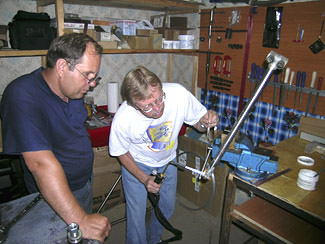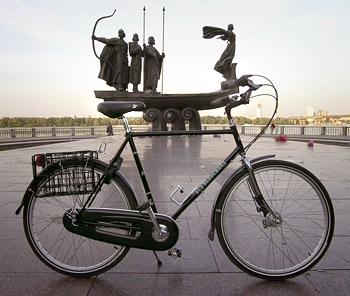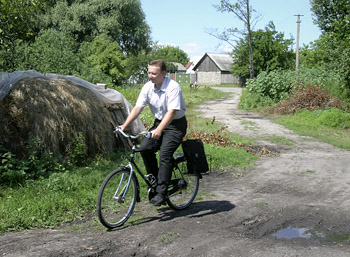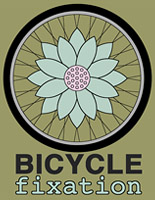
Doug showing Kostya the finer points of brazing.
My real job, which I've been doing for the last 30 years, is making and painting custom bicycles, so I have some background to design what is needed--but the challenge is that there is little in the States as a model for what is just practical transportation. That inspiration had to come from the past and other countries.
I should add that the primary purpose of these bikes are short runs in good clothes, although need often stretches what can be defined as "short." They are ridden on usually moderately level terrain at a walking effort of 8 to 10 mph, so that one doesn't need a shower and change of clothes at their destination. They can get really loaded down carrying stuff. I'll outline my journey toward make such a model.

What the world needs now....
The problem with them for this project is their 26 X 1 3/8" and 27 X 1 1/4" tires. In addition, it didn't make sense to spend the money and effort to fix them up for the same money that could buy a new one in the country where they were needed. However, I really came to appreciate how a Schwinn Suburban--with its fenders painted to match--could be taken apart and its steel derailleurs put back together, leaving it almost like new again after years of service. In other words, durability trumps over saving a pound or two on an already heavy bicycle. When I was growing up, I wouldn't be caught dead on one, however.
My next learning experience came in Holland (where bike transportation is normal and common); I picked up a steel framed RIH bicycle with a Brooks saddle. Dutch companies like Gazelle and Batavus make bicycles for transportation. Let me outline the features that make them practical.
- They use 7 speed (now often 8) internally geared hubs. Being able to shift when pedaling, coasting, or standing still is more convenient than derailleur systems. They don't wear out as fast either. They are especially helpful to those new to bicycling.
- They use roller brakes on the hubs. This makes rain and out of true wheels a non-issue. I've never liked coaster brakes because you can't scrub off a bit of speed as easily and can't put the crank in the best position after stopping. Those that are raised using them know how to overcome those obstacles but I've haven't learned to like them.
- They have a fully enclosed chain guard which keeps the chain and clothes clean.
- They have a ring lock on the seat stays that makes locking a bicycle in non-NYC areas simple and fast. You turn a key, push a lever, and remove the key and, voila, it prevents an impulse steal. A cable can also be attached to the lock.
- They have M shaped handlebars. I've found this shape to be more comfortable in around town trips than straight MTB type bars. The next alternative would be the figure 8 bar laid on its side, a shape more popular in Europe. It gives multiple hand positions.
- They have a kickstand integrated into the frame. Another example of convenience over weight concerns.
- They have generator lights. Trips aren't scheduled only during the day.
- They have extra long chain stays for basket heel clearance.
- They generally come with fenders, a rear rack, and a bell.
I designed the frames to use 26 X 1.75" because I felt this size was suitable for both paved and dirt road use. It is also a common size around the world. Over the years, I've made various samples of these frames and then modified the design after trying them. They are not far off of what has worked well for decades. Our translator's dad was able to laser cut specific frame parts.
Kostya is Chernobyl survivor who was an officer in the army sent in to clean up after the meltdown. I've trained him to build frames in Kiev. (One of our major sponsors wanted as much of the money raised as possible to be spent in the country itself. That is why we don't send in boxes of them from Asia.) Herbie is a college student that has worked in my shop this last year and is going over for 3 months during fall semester to give Kostya a hand. He is making these frames right now before he heads over in September. Some of these will be for sale here to help defray his costs, write me if you are interested. They will probably be around US$1500.00 with better parts and a custom paint job.

Ukrainian pastor making his rounds.
The problem with selling them in the States is that I'm not sure even experienced American cyclists would see them as meeting their needs. We are programmed to look for lightness, style, and "value" (defined as getting something as cheaply as possible, with Chinese production bicycles being the price benchmark). I'm not sure I would have given them a chance myself without the project to challenge my perceptions. The Dutch or Germans, however, would see them as ordinary--what they use everyday. In addition, they expect to pay for such quality--low price isn't as much a driving factor as it is in American culture.
Doug Fattic
An official project of the Niles Westside Seventh-day Adventist church and Ukraine Bicycle Tours.

